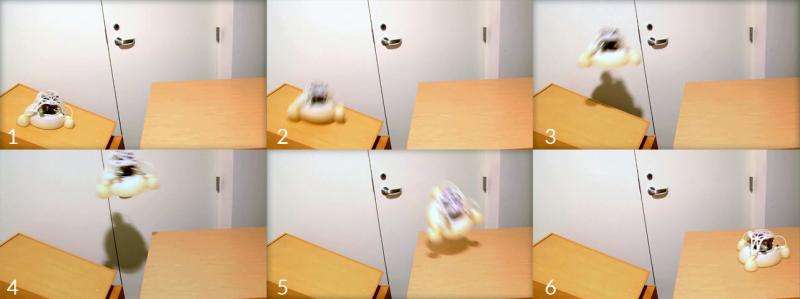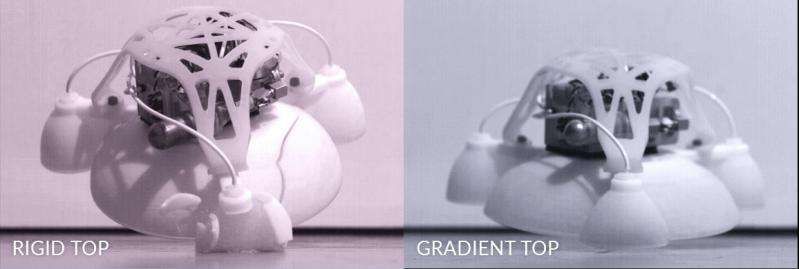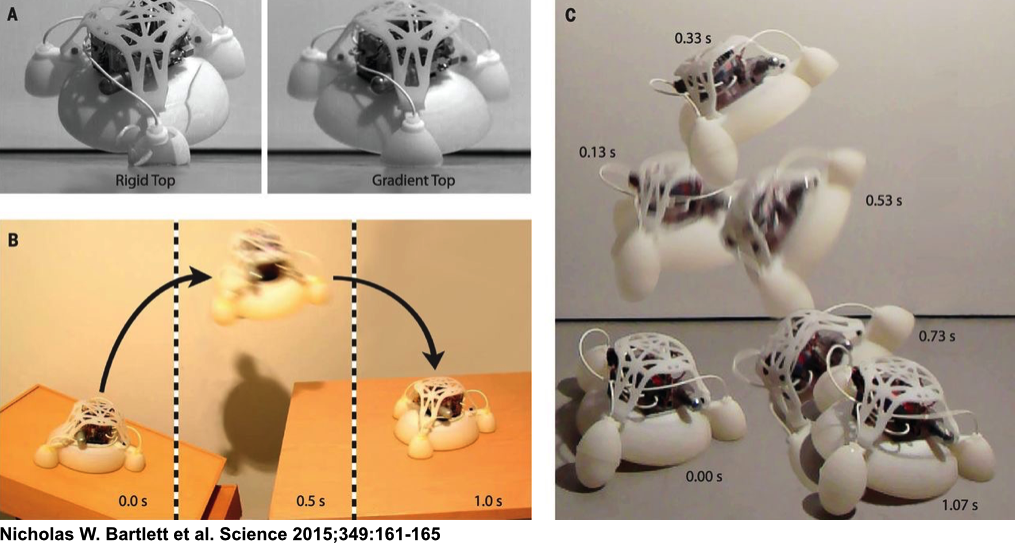 Will we one day in the future watch basketball games played by robots? Who needs a Lebron James on their team, when a 3D printed basketball player could jump 42 feet in the air? OK, perhaps we aren’t quite at that point yet, but researchers at the University of California, San Diego and Harvard University have created a 3D printed robot that has the ability to jump six times its own height, and even more impressive is the fact that it can do so over and over again without suffering a malfunction.
Will we one day in the future watch basketball games played by robots? Who needs a Lebron James on their team, when a 3D printed basketball player could jump 42 feet in the air? OK, perhaps we aren’t quite at that point yet, but researchers at the University of California, San Diego and Harvard University have created a 3D printed robot that has the ability to jump six times its own height, and even more impressive is the fact that it can do so over and over again without suffering a malfunction.
The team of researchers, including Nicholas W. Bartlett, Michael T. Tolley, Johannes T. B. Overvelde, James C. Weaver, Bobak Mosadegh, Katia Bertoldi, George M. Whitesides, and Robert J. Wood reported their findings in an article in Science Magazine, entitled “A 3D-printed, functionally graded soft robot powered by combustion“. The robot is 3D printed using multiple materials with varying properties, ranging from very rigid to extremely flexible. Powered by a mixture of oxygen and butane, it is capable of over 30 untethered jumps.
When most of us think of robots, we envision metal-constructed machines which are heavy and rigid in nature. The idea of watching one of these machines jump off of the ground is not feasible at all. However, the researchers partaking in this project aimed at blending both rigid and flexible materials to utilize each to their fullest potential.
“We believe that bringing together soft and rigid materials will help create a new generation of fast, agile robots that are more robust and adaptable than their predecessors and can safely work side by side with humans,” said Michael Tolley, an assistant professor of mechanical engineering at UC San Diego. “The idea of blending soft and hard materials into the robot’s body came from nature. In nature, complexity has a very low cost. Using new manufacturing techniques like 3D printing, we’re trying to translate this to robotics.”
With the recent popularity of 3D printing comes the ability to fabricate one-off creations at a fraction of the cost that they would have required just a decade ago. 3D printers today, have the ability to print in a large range of materials, colors, and composites. The ability to combine both soft and rigid materials within one print provides for a lot of potential for the future of the robotics industry.
Typically, soft robots are slow, but the idea of integrating more rigid components into a design allowed researchers to combine the benefits that soft robotics can provide — such as their ability to absorb shock, move more freely, and in the case jump off of the ground — with the benefits provided by those more rigid components. The robot that the researchers created can move fast because of the rigid portions, but also absorb shock and provide for a safer working environment for humans in their vicinity.
“This stiffness gradient, spanning three orders of magnitude in modulus, enables reliable interfacing between rigid driving components (controller, battery, etc.) and the primarily soft body, and also enhances performance,” explained the researchers. “Powered by the combustion of butane and oxygen, this robot is able to perform untethered jumping.”
The rigid layers printed into the robot also make for a much better backdrop for attaching electronics, computer systems and power sources to the robot’s interior, while the soft layers are created for more buoyancy, protection, and shock absorption. In the case of this experimental robot, which researchers admit took much iterating and testing, the top portion is 3D printed in a single piece, yet it features nine layers of varying stiffness and rigidity. The outer portion is very flexible and “rubber-like” while the inner portion is very stiff.
The researchers were able to generate comprehensive data on various stiffness levels to more-or-less systematically come up with the best possible properties for each of the nine different layers that the top portion of the robot is made up of.
The bottom part of the robot is completely flexible and features a chamber in which butane and oxygen can be injected. The two gases are ignited, causing the robot to launch off of the ground, in a similar fashion as a bouncing ball, after its pneumatic legs are inflated. These special legs have the ability to control the direction in which the robot jumps. Once the gases are burnt off, the bottom of the robot returns to its original form and it lands back on the ground without any damage to its components which include a mini air compressor, butane fuel cell, a battery, high-voltage power source, circuit board, and more.
So far, tests have shown that this robot is capable of jumping 2 1/2 feet into the air and another 1/2 foot laterally. It was able to do this over 100 times, while also falling from a height of four feet, 35 individual times, without any vital damage.
What do you think about this breakthrough technology? Will we one day soon see an integration between both soft and rigid robotics take place, ultimately enabling more capabilities for our computer based counterparts? Discuss in the 3D printed jumping robot forum thread on 3DPB.com. Check out the videos of this robot in action below.
Subscribe to Our Email Newsletter
Stay up-to-date on all the latest news from the 3D printing industry and receive information and offers from third party vendors.
You May Also Like
Gorilla Sports GE’s First 3D Printed Titanium Cast
How do you help a gorilla with a broken arm? Sounds like the start of a bad joke a zookeeper might tell, but it’s an actual dilemma recently faced by...
Nylon 3D Printed Parts Made More Functional with Coatings & Colors
Parts 3D printed from polyamide (PA, Nylon) 12 using powder bed fusion (PBF) are a mainstay in the additive manufacturing (AM) industry. While post-finishing processes have improved the porosity of...
$25M to Back Sintavia’s Largest Expansion of Metal 3D Printing Capacity Since 2019
Sintavia, the digital manufacturing company specializing in mission-critical parts for strategic sectors, announced a $25 million investment to increase its production capacity, the largest expansion to its operations since 2019....
Velo3D Initiates Public Offering in a Bid to Strengthen Financial Foundations and Drive Future Growth
Velo3D (NYSE: VLD) has been among a number of publicly traded 3D printing firms that have attempted to weather the current macroeconomic climate. After posting a challenging financial report for 2023,...




































